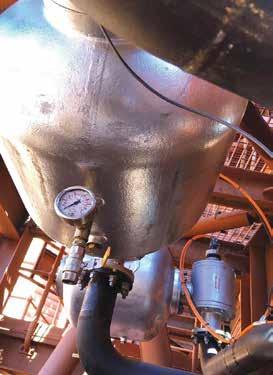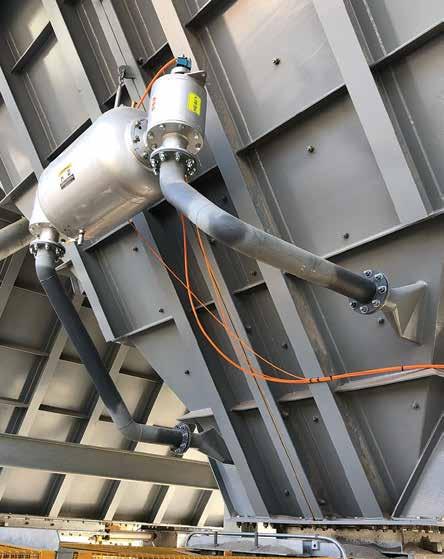
4 minute read
Handling the pressure
Handling the pressure: ESS unveils the safest air cannon yet

The build-up of materials in bulk storage systems is a common bulk materials handling issue. When silos and bunkers accumulate material around their perimeters, it can slow operations down or even stop bulk material flow altogether.
Air cannons are pressure vessels with attached valve mechanisms that blast air at high-velocity speeds approaching speeds of up to 1100 kilometres an hour, which is approaching the speed of sound (Mach 1). They are frequently used to dislodge bulk material build-up and allow for maximum storage capacity.
In the bulk materials handling sector, Air Cannons have numerous applications. They can solve bulk flow problems in silos, hoppers, chutes and storage piles and are often used where vibration is not practical, or other methods are too expensive.
While the power of air cannons provides a handy way to deal with bulk material blockages, the discharge of highly compressed, high-pressure air stored inside the vessel can cause severe injury or even death if not handled effectively. Dealing with compressed air, in general, is hazardous, even when using smaller air compressors.
The potential dangers air pressure pose include hearing injuries caused by the loud noises air compressors and related equipment make; eye injuries from direct exposure to the air or indirect exposure through displaced particles; high-pressure injection injuries (HPII) that cause local tissue damage; and aeroembolism, which is when compressed air enters the bloodstream.
ESS Engineering Services & Supplies has built on four decades of experience and designed an air cannon system for bulk material removal that is both safer and more effective than alternative arrangements. The system is available with both internal and external valves in four-inch and six-inch sizes.
Air, which is stored in 40-litre, 70-litre, 150-litre or 250-litre receivers, escapes directly through valves into a discharge pipe to affect the area of influence during dispersal.
The University of Newcastle ESS’S LATEST SYSTEM IS RAMPING UP PRODUCTIVITY FOR BULK FLOW OPERATIONS AND PROTECTING WORKERS AT THE SAME TIME. SAFE TO WORK INVESTIGATES. Bulk material build-up slows operations to a crawl if not corrected. ESS has delivered a robust design that can be filled just prior to being fired.
Research Associates (TUNRA) Bulk Solids was engaged to validate ESS’s claim the cannon’s valve was the most powerful on the market, according to ESS Engineering manager Mick Hutton.
“We invested a great deal of resources into making this a reality, and once we were confident that we could provide our customers with the best of the best, we devised a test procedure to test our valve configurations against our competitors on a level playing field,” he says.
“Results showed the ESS air cannon options outperformed all others in terms of peak blast force and blast impulse.”
TUNRA Bulk Solids organised blind testing of ESS’s Air Cannon valves against other air cannon valves available domestically and overseas, using random letter allocation and found the results exceeded in-house tests. TUNRA Bulk Solids consulting engineer David Bradney says the primary measures guiding the study are peak force and blast impulse.
“Each valve was tested in a deidentified state, and we randomly allocated a letter to each valve we tested,” TUNRA Bulk Solids consulting engineer David Bradney explains.
“The results were then provided to ESS with a photo to allow them to identify the valve and the corresponding letter identifier.”
However, power is not the only guiding principle that sets ESS’s design apart. Hutton says the system’s design is also safer than its competitors because the air cannon vessel is filled just before it being fired.
This minimises the time the air cannon is charged, which, in combination with remote administration via a sequence controller that determines fire time interval, ensures workers are not in the immediate vicinity when the tank is pressurised and firing.
“We’ve taken out the biggest part of the risk which is the time the vessel remains charged for,” Hutton says. “For 90 per cent of the time, it lays dormant without charge, whereas traditionally cannons are always charged with air and ready to go.
“In that scenario, it means you’ve got a pressurised vessel in an area where people frequent harbouring potential energy of 500 kilojoules that, if ruptured, could cause a catastrophe.
“With our air cannon system, we have developed a 150 litre cast vessel which effectively has an infinite life in terms of pressure cycles. It’s a more robust vessel than its rivals
ESS’s Air Cannon valves are hosted externally or internally. with no specific statutory inspection requirements as stipulated by AS3788.”
ESS mechanical engineer James Stievenard adds that the air cannon system includes other advances that help make it safer: “Our newly designed valve includes only one moving part with no metal-on-metal contact,” he says. “We have also engineered out the requirement for fatigue-prone components such as springs that can fail catastrophically.”
ESS is particularly proud of these engineering innovations, which have contributed to a safer design and improved performance.











